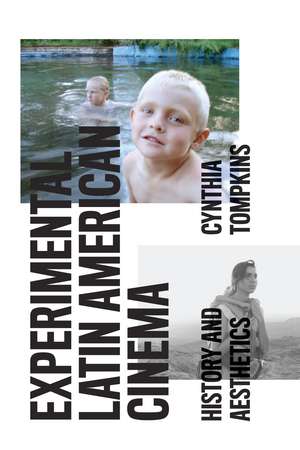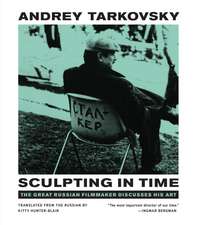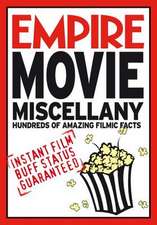Experimental Latin American Cinema: History and Aesthetics
Autor Cynthia Tompkinsen Limba Engleză Paperback – 15 feb 2013
Analyzing seventeen recent films by eleven different filmmakers from Argentina, Brazil, Cuba, Mexico, Paraguay, and Peru, Cynthia Tompkins uses a comparative approach that finds commonalities among the disparate works in terms of their influences, aesthetics, and techniques. Tompkins introduces each film first in its sociohistorical context before summarizing it and then subverting its canonical interpretation. Pivotal to her close readings of the films and their convergences as a collective cinema is Tompkins’s application of Deleuzian film theory and the concept of the time-image as it pertains to the treatment of time and repetition. Tompkins also explores such topics as the theme of decolonization, the consistent use of montage, paratactically structured narratives, and the fusion of documentary conventions and neorealism with drama. An invaluable contribution to any dialogue on the avant-garde in general and to filmmaking both in and out of Latin America, Experimental Latin American Cinema is also a welcome and insightful addition to Latin American studies as a whole.
Preț: 240.42 lei
Nou
Puncte Express: 361
Preț estimativ în valută:
46.01€ • 47.86$ • 37.98£
46.01€ • 47.86$ • 37.98£
Carte tipărită la comandă
Livrare economică 15-29 aprilie
Preluare comenzi: 021 569.72.76
Specificații
ISBN-13: 9780292762091
ISBN-10: 0292762097
Pagini: 306
Dimensiuni: 152 x 229 x 23 mm
Greutate: 0.45 kg
Editura: University of Texas Press
Colecția University of Texas Press
ISBN-10: 0292762097
Pagini: 306
Dimensiuni: 152 x 229 x 23 mm
Greutate: 0.45 kg
Editura: University of Texas Press
Colecția University of Texas Press
Notă biografică
Cynthia Tompkins, Professor of Spanish and Latin American Cultural Production at Arizona State University, was born and raised in Argentina. She is the author of Latin American Postmodernisms: Women Writers and Experimentation, as well as a significant number of refereed articles, and has translated and coedited numerous other publications.
Cuprins
- Acknowledgments
- Introduction. Mise-en-Scène, a Seemingly International Staging
- Part 1. A Neonoir Skew to the Action-Image
- Chapter 1. A Shimmering Suture: Fabián Bielinsky's Epileptic El aura
- Chapter 2. Slippery Criminal Pleasures: Intermediality and Voyeurism in Jorge Furtado's O homem que copiava
- Chapter 3. Endless Quest: Chasing Sex, Lies, and Money at the Gates of Hell in Heitor Dhalia's O cheiro do ralo
- Part 2. Road Movies
- Chapter 4. The Paradoxical Effect of the Documentary: Walter Salles's Central do Brasil
- Chapter 5. Twin Piques: The Double Discourse of Carlos Sorín's El camino de San Diego
- Chapter 6. Orphans' Solidarity: María Victoria Menis's El cielito
- Part 3. Drama
- Chapter 7. Sculpting Time: Inés de Oliveira Cézar's Como pasan las horas
- Chapter 8. The Past Engulfs the Present: Josué Méndez's Días de Santiago
- Part 4. Experimental Auteurism
- Chapter 9. Whether or Not to End One's Life: Carlos Reygadas's Japón
- Chapter 10. Crime and Self-Inflicted Punishment: Carlos Reygadas's Batalla en el cielo
- Part 5. Experimental Auteurism and Intertextuality
- Chapter 11. The Miracle of Female Bonding in Patriarchal Society: Carlos Reygadas's Stellet licht (2008)
- Chapter 12. Cyclical Scapegoating: Inés de Oliveira Cézar's Extranjera
- Chapter 13. The Irrevocable Nature of Curses: Inés de Oliveira Cézar's El recuento de los daños
- Chapter 14. Splintered Mirrors, Echoes, and Reverberations: Fernando Pérez Valdés's Madrigal
- Part 6. Experimental Pseudo-Documentary
- Chapter 15. Room with a View: Fernando Pérez Valdés's Suite Habana
- Chapter 16. Life Is and Is Not: Paz Encina's Hamaca paraguaya
- Conclusion: Possible Futures
- Notes
- Bibliography
- Index
Recenzii
Clearly organized and thoroughly researched, the book boasts a useful scholarly apparatus.
Descriere
This groundbreaking exploration of experimental Latin American film applies Deleuzian theories of cinema in a comparative approach to examine multiple genres and works from the most important national cinematic traditions

















